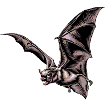Museum, University of Nebraska State

University of Nebraska State Museum: Mammalogy Papers
Document Type
Article
Date of this Version
2-15-1992
Citation
Biological Journal of the Linnean Society (1992) 45: 97–115.
The definitive version is available at https://www.blackwell-synergy.com.
Abstract
Upper canines in microchiropteran bats show a variety of cross-sectional shapes. A consistent feature of all species studied here is that the tooth is edged and not simply round or oval. Prominent sharp edges are positioned in several directions but particularly antero-medially toward the incisors and posteriorly toward the premolars. These edges appear to direct the cracks made in food items to the incisors or to the premolars. A continuous cutting edge is apparent in the occlusal view of the palate running from tip of canine to the ectoloph of the molars. Size and shape analysis indicates that larger bats have slender, rather than stouter, canines for their height, a condition that may be attributable to the nature of the prey. Most bats take prey that have little hard substance imbedded within. The compromises in tooth shape may vary between that of a terrestrial predator with short, conical canines for processing endoskeletal prey to that of a small flying predator with long, slender, edged canines for capturing and processing exoskeletal prey. Unicuspid teeth and how they might function in food break-up have been overlooked to the literature; such a study could lead to an understanding of how more complex teeth function.


Comments
Copyright © 1992, Linnean Society of London. Published by Blackwell Publishing. Used by permission.